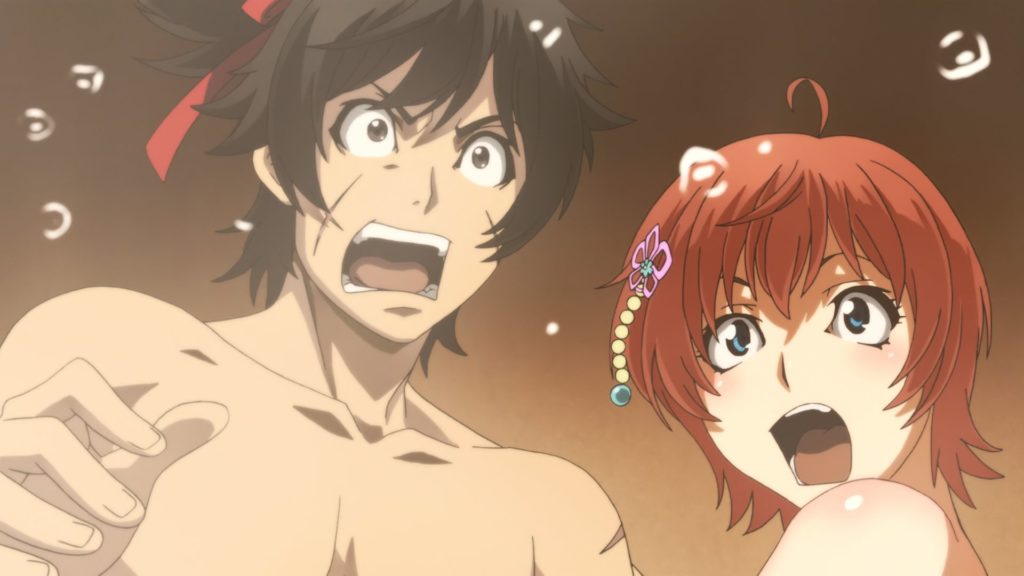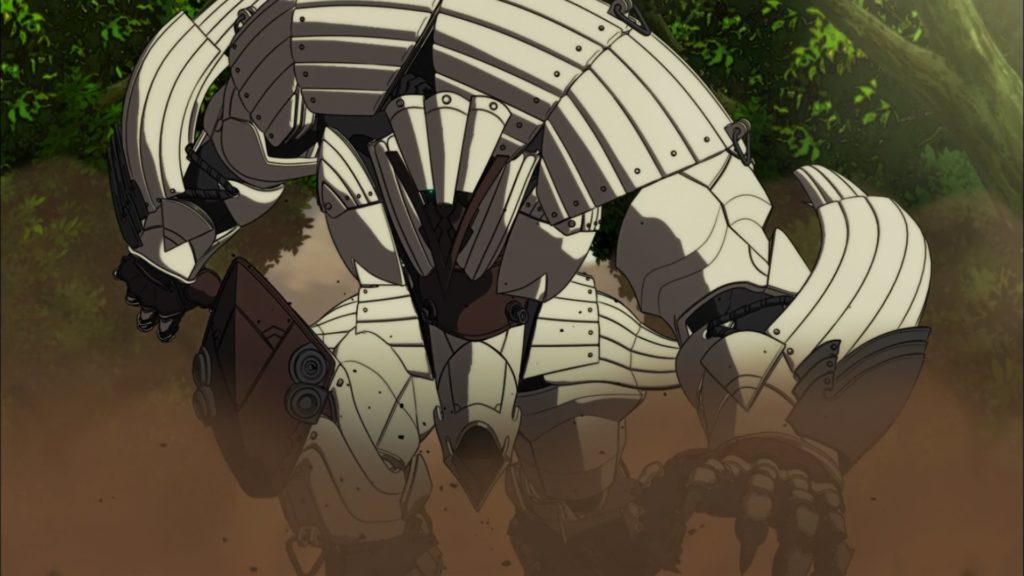Dai Shogun – Great Revolution Review
Set in 19th century Japan, 21 years after the arrival of the Americans and their Black Ships, Dai Shogun – Great Revolution presents an alternative take on history, where instead of Captain Matthew Perry forcing Japan to open up to foreign influence, the Americans are beaten back by Shigeyoshi Hitotsubashi and his giant armoured mecha, the Onigami known as Takemikazuchi; destroying the Black Ships with its overpowering energy beam. With the Americans no longer in the picture, the Meiji Restoration never happens, resulting in a time of political turmoil and upheaval, as the Shogun dies without an apparent heir and Japan falls into the hands of his greedy and lustful prime minister. Disliking the Prime Minister’s rule and seeing a chance to grab power for himself, Shigeyoshi and his loyal band of retainers, the Shinsengumi, rise in rebellion. Despite killing the Prime Minister, it turns out that the Shogun had fathered an heir who had escaped the turmoil: the series’ hero, Keiichiro Tokugawa.

Keiichiro however, has no knowledge of his noble heritage, and spends his time with his best buddy Hyakusuke brawling in the streets and lusting after women using the bathhouse that he lives in. This seemingly idyllic life can’t last forever, as he is soon hunted down by a mysterious assassin – the buxom and venomous Houkouin. As his noble heritage is revealed, Keiichiro uncovers his own Onigami: Susanoo, and manages to drive Houkouin off with the help of the female Iga ninja, Kiriko. As the dust settles, Keiichiro’s adoptive grandmother reveals he is the heir to the Tokugawa Shogunate and must fulfil his duty by travelling to Edo and reclaiming it from Shigeyoshi.
While this is not a series that is new to me, having watched it when it first debuted on Crunchyroll several years ago, I still think that the backstory to the series is quite fascinating at a glance, as it’s not often you see an anime look at the period of history around the Meiji Restoration and the Boshin War. So, I did expect some fireworks here; and while it does bring in some of the social and political issues of the time, it sadly squanders its potential by presenting itself as a harem fantasy, pushing history into a corner and focussing squarely on Keiichiro’s buxom babes.

The first half of the series sets up this harem, slowly introducing both the three main girls and several of the side characters, which it actually does quite well. Kiriko is shown to be quite proficient at combat and martial arts and can stand on her own in a fight; the fox-girl Chiharu clearly has her own tale to tell around her demons as Keiichiro sways her to giving up her life of prostitution, and Asai Hyogo is in pursuit of her father’s killer to exact her revenge.
While most harem series would look at each girl in turn and have the main character solve her problems, Dai Shogun really struggles to move things forward in a meaningful way, as Keiichiro spends the next few episodes languishing around town and trying to lose his virginity so he doesn’t have to pilot Susanoo (as for some reason his ability to pilot the mecha relies on his lack of sexual experience). There are a couple of action set pieces worked in, such as the continued battle against Houkouin and a fight against some sky pirates, that are designed to warm everyone up and introduce the key concepts on how the mechas work; but it is slow-going and it doesn’t particularly change any of the characters’ goals or motivations.
It’s simply that the characters don’t have much depth beyond the cowardly womaniser, the bungling sidekick, the sexy love interest, the aggressive animal girl and so on. It’s certainly a shame because they do have room for growth based on their introductions, but the story just never takes them that way. A couple of them also get slowly forgotten about as the series progresses, with Asai in particular becoming completely irrelevant by the end. Her arc pits her against the Shinsengumi, and while it tries to show her rising above the need for vengeance, it doesn’t execute it effectively enough and makes her far too passive for what she has potentially had to go through. At some point it just switches to Kiriko as the female lead and the setting up of the harem situation in the first half just seems wasted as it eventually abandons the idea.

It does turn out to be a switch for the better though, as the second half ramps things up with elements the first half sorely needed. A competent sixth episode ploughs into the series’ backstory, as Shigeyoshi’s rebellion against the government plays out, with some particularly gory scenes as the entire court is sacrificed to the moon to break the seal that was placed on Takemikazuchi after the battle against the Americans 21 years earlier. It may be one big power grab, but it’s hard to see Shigeyoshi as truly evil when he and the Shinsengumi are slicing up Jabba the Hutt-inspired slimeballs who have up to now spent their days surrounded by naked concubines.
Whether this could be considered fanservice or not is arguable, but the sexual elements were definitely a turn-off as they played it far too straight and narrow. You’ll find a lot of typical elements like peeping in the public bath, boob-grabs, frequent nudity, clothes shredding and even more serious sexual assault; but if any of it was meant to be funny it completely fails at producing a convincing comedy. Keiichiro’s tendency to break out in hives whenever he is touched by a woman was supposed to fill that gap, but personally didn’t tickle my funny bone.
Surprisingly however, a game of strip rock-paper-scissors does give us something different by focussing on a bunch of foreigners that were formerly in the employ of the old government. These guys are clearly set up as villains and does show a little of how the attitude towards westerners was in decline at the time.

Looking at how this plays out I found the action sequences that did not involve the Onigami mechas to be more enjoyable as they at least seemed to have some stakes to fight for, particularly in the stand-off with these foreigners who have immediate access to weaponry that Keiichiro and the gang don’t. Yet when it comes to the Onigami fights, they are typically over in one move as soon as Susanoo transforms into its beast god mode, as of course it being the hero’s machine means it has to be overpowered.
It may have helped if the series actually looked okay, but it struggles to look average at best and seems to use an odd combination of 2D and CGI for the characters that renders them as extremely stiff in certain scenes. Breast physics often make them look like giant lumps of Plasticine, while hair strangely bobs up and down instead of swaying in the wind. It’s easy to laugh at how bad these effects look in certain scenes, but at the end of the day it just makes the series look really out of sorts with itself.

The soundtrack at least works to fit the series well and is helmed by various composers at Bandai Namco Studios and music production company MONACA, the most prolific being Keiichi Okabe, who has produced music for anime series such as Aikatsu! and Wake Up! Girls, and also video games such as NieR:Automata. The voice cast is also surprisingly high profile for what you may imagine to be a more low-budget title, featuring the likes of Tetsuya Kakihara (Fairy Tail, Gurren Lagann) as Keiichiro, Ayako Kawasumi (Fate/stay night, Shakugan no Shana) as Kiriko, Yukari Tamura (Naruto Shippuden, Steins;Gate) as Chiharu, and Youko Hikasa (K-On!, New Game!) as Asai.
MVM Entertainment’s release of the series is subtitle only and packs in all 12 episodes on a single disc along with the usual creditless opening and closing animations along with some Sentai Filmworks trailers. The use of a single disc makes it easier to tell this is a budget title, with Sentai seemingly not feeling the need to expense spreading the series out over 2 discs for their masters.

Although it does have some positives, Dai Shogun – Great Revolution is not a series I would recommend. While the backstory has a lot of potential, it spends too much time going nowhere with its harem plot, and any moves it could have made with the setting come far too late in the game to make a difference. The animation is not great, and the bizarre use of CGI animation on breasts and hair gives it a rushed and cheap feel; while the fanservice is played too straight to be funny, and the clear instances of sexual assault may be too much for some.


